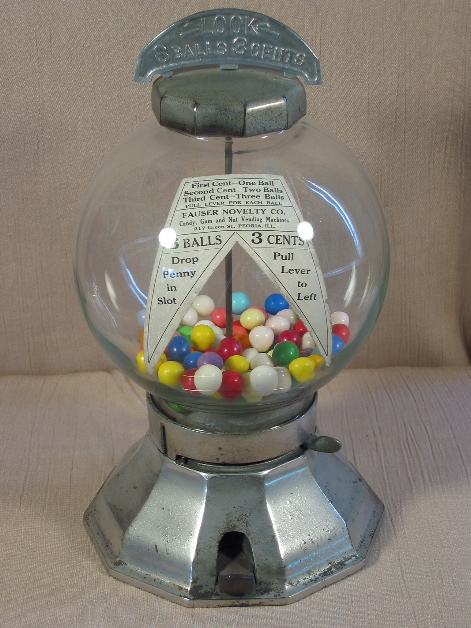___________________________________________________________________________________________
Simpson Famous 1-2-3 (a.k.a. "Simpson Leebold")

___________________________________________________________________________________________

R. D. Simpson Co., Columbus, OH, c. 1923, 13 1/2. The machine is well made of nickel-plated cast iron. It's one of several Simpson models with the same body but different mechanisms. This model gave 1, then 2, then 3 gumballs for each penny, for a total of 6 balls for 3 cents, and then started again back at one. The Pen-Nick gave 1 gumball for a penny and 5 gumballs for a nickel, and still others gave one gumball or two gumballs for each penny.
I can't speak for these last configurations, but for the 1-2-3 and the Pen-Nick, you have to pull the handle the number of times you expect the machine to dispense a gumball---it won't just drop multiple balls with one pull. This is unlike, say, the Columbus 14 which is a 1-2-1-2-3 machine that has 1, 2, or 3 holes in each position on the vending wheel, which allows it to drop 1, 2, or 3 gumballs with each pull depending on which position is next. That's a simpler way to go and I'm not sure why Simpson opted for a more complicated design, but they did. It can be quite perplexing if you don't know that you need to continue to work the lever, and you might think the machine is broken or that it has the wrong globe on it.
The example pictured above is 100% original. There's a story behind this machine, and a lesson learned for me and hopefully a lesson to-be-learned for others. I bought the machine in the early 1990's from a non-collector in South Carolina, who had 2 of these tucked away in his closet. His grandmother had them in a tavern she owned in the 1940's, and they got passed to her daughter and then to the daughter's son---the guy with whom I was dealing. He stuck them in closet and they sat there for 10 years. He eventually decided to buy some land, and sold these in order to help with the down payment. I was the buyer. When I got them they had so much tarnish on them that I didn't think any nickel was left. But I was wrong; I polished them and found a nice nickel finish underneath.
Not long after that I decided that I'd made an irrevocable mistake. I should have left them alone and appreciated them for what they were, which was 2 great examples of this machine, aged in a way that made them unusual and---to most collectors---more interesting than the usual nickel-plated version. These are not uncommon machines, but in the years since I bought these I've seen only a couple other examples of Simpsons that had the black tarnished look that these had when I got them. They looked great just as they were when I got them, and I blew it by cleaning them.
The most important dictate of good medical care is also the most important dictate of good stewardship: First, do no harm. I violated that rule through ignorance, and I wish I hadn't.
A long time after I made this mistake I was able to buy a Simpson Pen-Nick that had the same kind of old tarnished finish I'd removed from the machine above. I didn't make the same mistake twice.
By the way, the marquee for this model has been reproduced with excellent quality, so be careful when buying one of these machines with a marquee. The original marquees are hard to come by, and most Simpson 1-2-3's don't have one. I don't know how to tell the reproductions from the originals, but you should at least be aware that they exist.
Many thanks to Shawn Flock for his critical review and content suggestions.
___________________________________________________________________________________________
___________________________________________________________________________________________
©Small Vintage Vending 2003